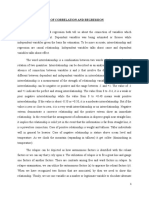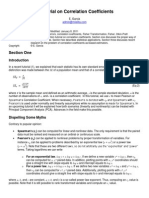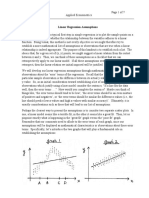Linear Modeling
Uploaded by
api-242750497Linear Modeling
Uploaded by
api-242750497Andrew Belov
Professor Julie Humphreys
Math 1040 Statistics
5/3/2017
Linear Modeling
In our first activity, we learned about linear regression. The linear
regression model is a method in which we may observe and conclude if a
specific set of data presents a negative or positive linear relationship. The
data we observe comes from a scatter plot or a graph. The variables in the
data set are referred to as explanatory (X), and response (Y). We use the
formula for the linear correlation coefficient (r), and compare the
absolute value of (r), to a critical value, which is based on a sample size. If
the r value is larger than the critical value, we can then determine if a
correlation exists. The closer the (r) value is to 1 or -1, the correlation is said
to be strong positive, or a strong negative. From here we calculate the
coefficient of determination (r2). This value is expressed as a percentage,
and explains the variance in X, can be explained by Y. We went on to find a
least squares regression line, dictated by y hat. (y^=ax+b) This regression
line gives us the equation of our data. We use this Y^ formula to make
predictions regarding our variables.
In our activity, we looked at a survey of adult Americans regarding
their commute times to work as well as their well-being score (given by a
survey). Our Explanatory variable was commute time (in 5,10, 15... mins
etc.) Our Response variable was the corresponding well-being score. We
found that with a sample size (n)=10, the corresponding critical value was
0.632 We compared the (r) value, and found that a strong negative
correlation existed. Our r2 value came out to be .8116, meaning, 81.16% of
the variation in y (well-being score) can be explained by x (commute time).
The longer the commute time, the worse the score becomes. We then used
the y hat equation and made a prediction for a well-being score with a
commute time of 120 minutes. The well-being score ended up with a low
value.
This method taught us how to make predictions about data. As long as
the data has a linear relationship, and is within your data set, you can make
predictions on what to expect on average, for just about anything.
You might also like
- Handout 05 Regression and Correlation PDFNo ratings yetHandout 05 Regression and Correlation PDF17 pages
- Report Statistical Technique in Decision Making (GROUP BPT) - Correlation & Linear Regression123No ratings yetReport Statistical Technique in Decision Making (GROUP BPT) - Correlation & Linear Regression12320 pages
- Simple Linear Regression: Definition of TermsNo ratings yetSimple Linear Regression: Definition of Terms13 pages
- Biostatistics (Correlation and Regression)100% (1)Biostatistics (Correlation and Regression)29 pages
- Short Term Training Programme On Data Analytics Using SPSS and RCMDRNo ratings yetShort Term Training Programme On Data Analytics Using SPSS and RCMDR20 pages
- Regression Test Lesson Notes (Optional Download)No ratings yetRegression Test Lesson Notes (Optional Download)5 pages
- Chapter 13 Quick Overview of Correlation and Linear RegressionNo ratings yetChapter 13 Quick Overview of Correlation and Linear Regression17 pages
- Ch 4- Correlation and Regression YARA&LAMANo ratings yetCh 4- Correlation and Regression YARA&LAMA27 pages
- Czekanowski Index-Based Similarity As Alternative Correlation Measure in N-Asset Portfolio AnalysisNo ratings yetCzekanowski Index-Based Similarity As Alternative Correlation Measure in N-Asset Portfolio Analysis1 page
- Lecture-25 CORRELATION - 34861774 - 2024 - 05 - 04 - 23 - 38No ratings yetLecture-25 CORRELATION - 34861774 - 2024 - 05 - 04 - 23 - 384 pages
- QT_LESSON 8-Regression & Correlation.docxNo ratings yetQT_LESSON 8-Regression & Correlation.docx12 pages
- Simple Linear Regression and Correlation Analysis: Chapter FiveNo ratings yetSimple Linear Regression and Correlation Analysis: Chapter Five5 pages
- Week 3 Supplemental Handout - Linear Model AssumptionsNo ratings yetWeek 3 Supplemental Handout - Linear Model Assumptions7 pages
- Data Science and Bigdata Analytics: Dr. Ali Imran JehangiriNo ratings yetData Science and Bigdata Analytics: Dr. Ali Imran Jehangiri20 pages
- Module 6 RM: Advanced Data Analysis TechniquesNo ratings yetModule 6 RM: Advanced Data Analysis Techniques23 pages
- Regression Course For Second Year (Chap 1-3)No ratings yetRegression Course For Second Year (Chap 1-3)59 pages
- Regression: Leech N L, Barret K C & Morgan G A (2011)No ratings yetRegression: Leech N L, Barret K C & Morgan G A (2011)35 pages
- Unit III: Correlation and Regression AnalysisNo ratings yetUnit III: Correlation and Regression Analysis16 pages
- Name-Simran Kaur Syal Subject - Financial Econometrics Assignment No. 4 Q. Explain BLUE in Detail and Conditions For The Same? AnsNo ratings yetName-Simran Kaur Syal Subject - Financial Econometrics Assignment No. 4 Q. Explain BLUE in Detail and Conditions For The Same? Ans4 pages
- Review: I Am Examining Differences in The Mean Between Groups100% (1)Review: I Am Examining Differences in The Mean Between Groups44 pages



























































